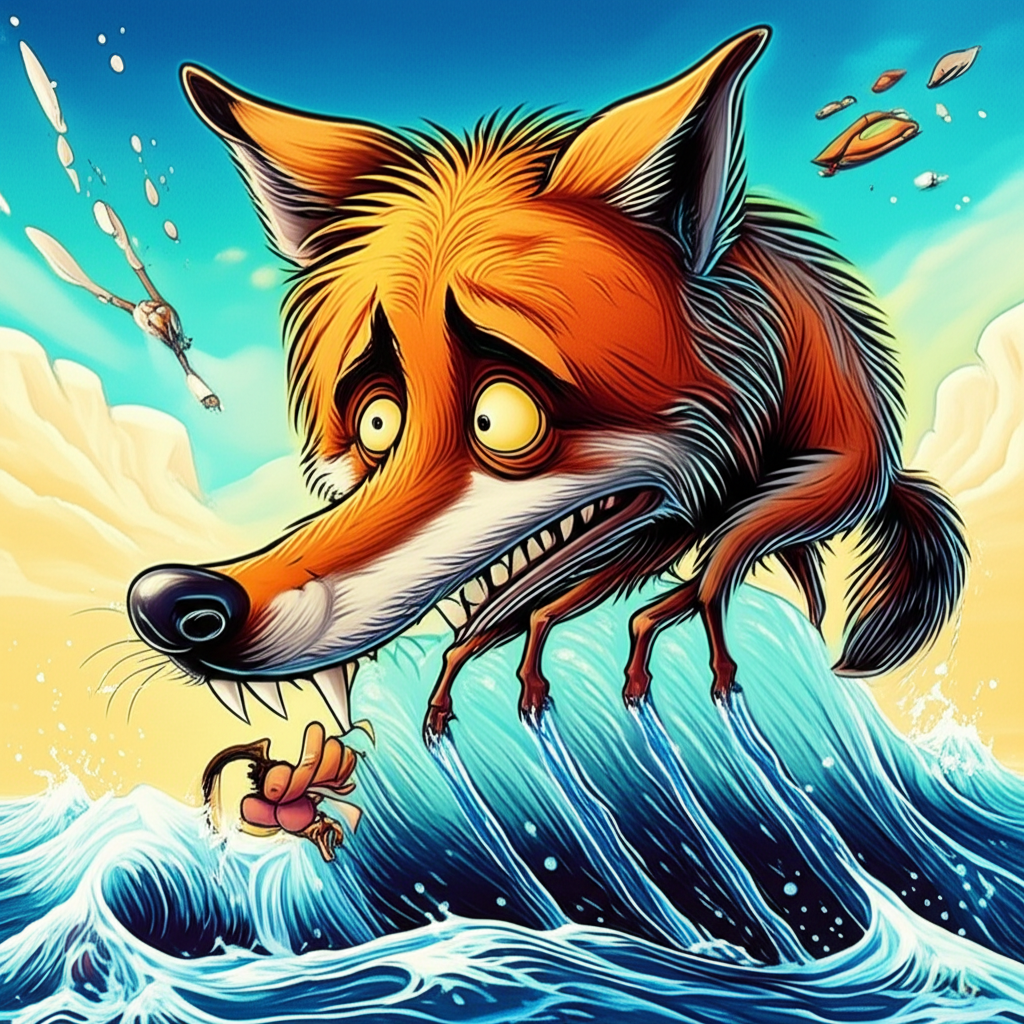
This article delves into a hypothetical narrative that interweaves elements from two rich and distinct mythological traditions: the North American Indigenous Trickster figure, Coyote, and the Inuit Mother of the Sea, Sedna. It is important to state from the outset that this specific fusion of characters and events is not a traditionally existing myth, but rather a conceptual exploration for cultural, historical, and educational understanding, crafted for the purpose of this article. It draws upon the established characteristics and themes of each figure to imagine a new story in the spirit of ancient storytelling. These are traditional stories told by ancient peoples to make sense of their world, and they are presented here solely for academic and cultural appreciation.
Origins and Cultural Background
The figure of Coyote originates from the diverse oral traditions of numerous Indigenous peoples across North America, including the Plains, Plateau, and Great Basin regions. In these cultures, stories were not merely entertainment; they were vital vessels for transmitting knowledge, ethics, and worldviews across generations. The people who told these tales lived in intimate relationship with the land, observing the cycles of nature, the behaviors of animals, and the often unpredictable nature of existence. Their worldview was deeply animistic, seeing spirit and life in all things—animals, plants, rocks, and natural phenomena. Through Coyote, they explored themes of creation, destruction, morality, folly, and the constant interplay between order and chaos.
Sedna, on the other hand, is a central figure in the mythology of the Inuit people, who have for millennia inhabited the harsh and beautiful Arctic regions of North America. Their world was one of ice, snow, and the vast, life-sustaining but also perilous sea. Survival depended on hunting marine mammals, and thus, the relationship with the sea and its spirits was paramount. The Inuit worldview emphasized balance, respect for all life, and the understanding that human actions could profoundly impact the natural world. Their myths often explained the origins of animals, the weather, and the consequences of violating taboos, reflecting a deep spiritual connection to their environment and an understanding of its awesome power. These narratives were crucial for teaching lessons about humility, perseverance, and the delicate equilibrium required for life in such a demanding landscape.
Character Descriptions
Coyote (The Trickster): In Indigenous mythologies, Coyote is not a deity to be worshipped, but a powerful and complex spirit being, often depicted as a physical coyote or a human-like figure with coyote attributes. He is the quintessential Trickster: cunning, selfish, vain, and insatiably curious. He is a master of disguise and deception, often getting himself and others into trouble through his insatiable appetites or desire for amusement. Yet, paradoxically, Coyote is also a culture hero. His blunders often inadvertently lead to beneficial outcomes for humanity—like bringing fire, teaching survival skills, or shaping the landscape. He embodies the unpredictable, chaotic, and often humorous aspects of life, symbolizing adaptability, the breaking of norms, and the profound lessons learned through mistakes. He is neither good nor evil, but a force of change, perpetually testing boundaries and challenging the established order.
Sedna (Mother of the Sea): Sedna, known by various names across Inuit dialects (e.g., Nuliajuk, Takannaaluk), is the most powerful spirit of the Arctic sea. Her story is one of profound transformation from a human girl to the source of all marine life. She is not a deity in the Western sense, but a revered and feared entity whose anger can bring famine and whose benevolence ensures sustenance. Symbolically, Sedna represents the life-giving yet unforgiving nature of the Arctic environment, the deep connection between humans and the sea, and the consequences of betrayal and disrespect. Her physical transformation—her fingers becoming the seals, whales, and fish—symbolizes the origin of life from suffering and the interconnectedness of all beings in the marine ecosystem. She embodies the ultimate power over life and death in the Arctic world, dictating the availability of food and demanding respect and proper conduct from hunters.
The Main Story: The Trial of Sedna’s Descent
In the deep reaches of the world, where the land met the endless, frigid sea, lived the young woman Sedna. Her life on the ice-bound coast was one of hardship and longing, her spirit chafing against the constraints of her village. One day, a mysterious hunter arrived, promising her a life of comfort and abundance. Sedna, swayed by his charms, left her home, only to discover her new husband was a monstrous bird-spirit, and her new home a desolate, guano-fouled island.
Her father, hearing of her plight, journeyed across the turbulent waters to rescue her. As they fled in his kayak, the bird-spirit husband, enraged, stirred a colossal storm. The waves rose like mountains, threatening to capsize their fragile vessel. In desperation, fearing for his own life, Sedna’s father cast her overboard. She clung to the kayak’s edge with frozen fingers, but he, in a moment of terror, hacked them off with his axe. Her severed digits, sinking into the icy depths, transformed into the seals, whales, and fish that would one day sustain her people. Sedna, broken and betrayed, sank into the abyss, her heart a cauldron of sorrow and burgeoning power.
It was then, as Sedna descended into the crushing darkness, that Coyote, the ancient Trickster, grew bored with his usual antics of reshaping mountains and outsmarting bears. He had been watching, his keen, mischievous eyes following the tragic drama from the shore, a glint of curiosity in their depths. The raw power of Sedna’s transformation, the birth of life from such profound suffering, piqued his interest. This was no ordinary descent; this was the forging of a new power, an unprecedented event in the deep.
Coyote, ever the instigator, decided this profound shift required a "trial"—not of guilt, for Sedna was innocent of her suffering, but a trial of her burgeoning dominion. He slipped effortlessly through the layers of water, his form shifting like a shadow, until he stood before the newly forming Mother of the Sea in her abyssal realm. Sedna, now a being of immense power, sat amidst the swirling currents, her hair flowing like kelp, her eyes glowing with the deep light of the ocean floor. Around her, the nascent forms of seals and fish swirled, born from her sacrifice.
Coyote, with a wry grin, addressed her. "So, little human-who-was, you have come to rule the deep? You, who could not even hold onto a kayak? What knowledge do you possess of the hunt, of hunger, of the endless cycle of the living and the consumed? Will you bring plenty or only the echoes of your own pain?"
Sedna, her voice resonating with the sound of the deep ocean, replied, "My pain birthed these creatures. My suffering connects me to every ripple, every hunger, every life in these waters. I know the hunt because I am its source. I know hunger because I have felt its gnawing emptiness. I know plenty because I alone can command its flow."
Coyote, ever the skeptic, challenged her further. "Prove it, then! Show me this ‘plenty.’ Show me this ‘connection.’ Show me that your rule will bring balance, not just the cold wrath of a wronged spirit."
Sedna closed her eyes. The waters around them began to stir with an unseen force. Visions of teeming schools of fish, of sleek seals diving for prey, of great whales breaching the surface for air, filled the abyssal chamber. Then, the vision shifted: the waters grew barren, the creatures vanished, and a profound silence descended, reflecting the famine that would strike the human world if she withheld her bounty. She demonstrated not just power, but a profound understanding of the delicate balance, the ebb and flow of life and death, the intricate web that connected her to the humans above.
Coyote, for once, was genuinely silent, his usual smirk replaced by a look of contemplation. He saw not just power, but a terrible, necessary wisdom born of suffering. He recognized the profound shift in the cosmic order. "Indeed," he finally conceded, his voice softer than usual. "The deep has a new heart, one forged in pain, yet capable of immense generosity. Your trial, it seems, was not yours alone, but a lesson for all—of consequences, and of the enduring, mysterious source of life."
And with that, Coyote, ever restless, vanished as swiftly as he had appeared, leaving Sedna to assume her eternal mantle as the Mother of the Sea, the silent guardian of the deep, her trial having cemented her power and her profound, dual nature.
Symbolism and Meaning
This imagined narrative, drawing upon established mythologies, offers rich symbolic meaning. Coyote’s involvement in Sedna’s transformation highlights his role as a catalyst for change and a bringer of new order, even through disruptive means. He represents the unpredictable forces that challenge established norms, forcing individuals and the world itself to adapt and evolve. His "trial" serves not as a judgment of Sedna’s worth, but as a symbolic test of her nascent power and a recognition of her new, profound role in the cosmic order. It emphasizes that even profound suffering can lead to a source of immense power and life.
Sedna, in this context, symbolizes the ultimate interconnectedness of humans and the natural world, particularly the sea. Her transformation from a wronged human to the mother of marine life underscores the sacredness of all living things and the severe consequences of human betrayal or disrespect towards nature. Her power over the abundance of the sea represents the delicate balance of life and death, and the crucial need for humility, gratitude, and proper conduct when interacting with the environment. The story, even in its hypothetical fusion, speaks to themes of creation from suffering, the cyclical nature of life, and the establishment of natural laws through profound events.
Modern Perspective
In contemporary society, figures like Coyote and Sedna continue to resonate, often reinterpreted through various lenses. Coyote, the Trickster, is a perennial archetype in literature, film, and cultural studies, symbolizing rebellion, chaos, and the subversion of authority. He appears in modern stories as a figure who challenges societal norms, highlighting the importance of questioning, adapting, and finding humor in life’s absurdities. His stories are studied in Indigenous literature courses as profound expressions of cultural identity, resilience, and complex moral philosophy.
Sedna, too, finds new life in modern interpretations. She is often seen as a powerful symbol in environmental movements, representing the profound impact of human actions on marine ecosystems and the urgent need for conservation and respect for the ocean. Feminist scholars interpret her story as a narrative of female power emerging from trauma and betrayal, transforming suffering into a source of immense strength and creation. She appears in contemporary Indigenous art, children’s literature, and cultural festivals as a vital link to Inuit heritage and a reminder of the deep spiritual connection to the Arctic environment. The exploration of hypothetical fusions like this one also highlights how mythologies, while distinct, can share universal themes and archetypes, inviting cross-cultural dialogue and creative interpretation.
Conclusion
The narrative of Coyote and the Trial of Sedna’s Descent, while an imagined fusion of ancient traditions, serves as a powerful reminder of the enduring human capacity for storytelling. These are cultural stories, born from the imaginations and experiences of ancient peoples, and are not to be taken as literal truths or objects of belief. As Muslims, we recognize that Allah alone is the true Creator and Sustainer of all existence, and all power and wisdom ultimately derive from Him.
Nevertheless, such myths offer invaluable insights into cultural heritage, the creative spirit, and the diverse ways humanity has sought to understand its place in the world. They are testaments to the power of imagination, the transmission of moral lessons, and the profound human desire to connect with the mysteries of life through narrative. Through such stories, whether traditional or imaginatively constructed, we gain a deeper appreciation for the rich tapestry of human thought and the timeless art of storytelling.





